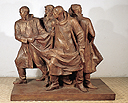
 |
Slovakia We Were in the Resistance Slovakia always had a certain cultural autonomy within the CSSR. They had their own Slovakian schoolbooks and their own history books. As with the Czechs, the liberation of Slovakia by the Red Army was also important for the Slovaks. However, the memory of the Slovakian national revolt of 29 August 1944 played a much greater role. In the construct of Slovak history, the rebellion stands for the chasm between the authoritarian regime that was allied with Germany and the Slovakian people. In this sense, the rebellion was later interpreted in the CSSR as a symbol of the anti-Fascist stance of the Slovaks. |
| In 1974 a memorial to the Slovakian national rebellion was erected in Bratislava. In the foreground the postcard shows the figure of a Slovakian partisan. The unity of the nation is symbolized by the two mourning women. They recall the suffering of the people and their support for the fight of the partisans. This memorial replaced in part the Slavín as the location for state rallies. The remembrance of the liberation was covered over to a certain extent by that of the Resistance. | |
| Partisans were often represented between 1948 and 1989, without undergoing any great shift in emphasis. Pictures of fighting were almost never shown. In the fine arts the partisans appear as guardians in the mountains, as for example in the sculpture by Tibor Bartfay. | |





